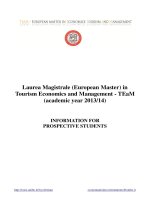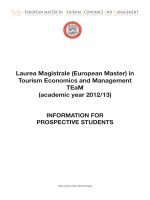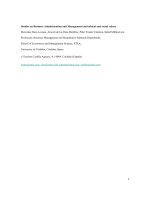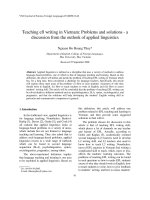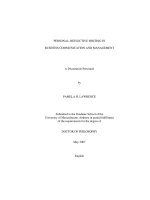personal, reflective writing in business communication and management
Bạn đang xem bản rút gọn của tài liệu. Xem và tải ngay bản đầy đủ của tài liệu tại đây (745.11 KB, 201 trang )
PERSONAL, REFLECTIVE WRITING IN
BUSINESS COMMUNICATION AND MANAGEMENT
A Dissertation Presented
by
PAMELA H. LAWRENCE
Submitted to the Graduate School of the
University of Massachusetts Amherst in partial fulfillment
of the requirements for the degree of
DOCTOR OF PHILOSOPHY
May 2007
English
UMI Number: 3275795
3275795
2007
UMI Microform
Copyright
All rights reserved. This microform edition is protected against
unauthorized copying under Title 17, United States Code.
ProQuest Information and Learning Company
300 North Zeeb Road
P.O. Box 1346
Ann Arbor, MI 48106-1346
by ProQuest Information and Learning Company.
© Copyright by Pamela H. Lawrence 2007
All Rights Reserved
PERSONAL, REFLECTIVE WRITING IN
BUSINESS COMMUNICATION AND MANAGEMENT
A Dissertation Presented
By
PAMELA H. LAWRENCE
Approved as to style and content by:
____________________________________
Anne Herrington, Chair
_____________________________________
Charles Moran, Member
_____________________________________
Linda LaDuc, Member
_____________________________________
Joseph Bartolomeo, Department Chair
Department of English
DEDICATION
To my amazing family without whose support I would not have
completed this dissertation.
ACKNOWLEDGMENTS
I would like to thank my chair, Anne Herrington, who has carefully and
thoughtfully guided me through this tremendous test of strength. I also must thank my
committee member Charles Moran, who always made it possible for me to give him yet
another draft. And to my third committee member Linda LaDuc, many thanks for
providing me both the time and encouragement I needed to get this dissertation behind
me.
I also want to thank all of my colleagues who participated in this project, those I
surveyed and interviewed as well as those who offered professional and scholarly insight.
An additional thanks to my colleagues in the Isenberg School’s Business
Communication Program for continuing to cheer me on. And to my colleague Sharon
Desmond Paradiso, thank you for the hand holding, pedagogical and intellectual debates,
and the many laughs over the years.
To my family and friends, I cannot cover here how much help and support I have
gotten from each of you. You have made completing this dissertation a reality. To each of
you I owe a special and loving thanks. To my husband, Terry, to my children, Isabelle,
Spencer, and James and to my parents, my big brother, and my dear friend Heather, thank
you.
v
ABSTRACT
PERSONAL, REFLECTIVE WRITING IN
BUSINESS COMMUNICAITON AND MANAGEMENT
MAY 2007
PAMELA H. LAWRENCE, B.A., GEORGE MASON UNIVERSITY
M.A., UNIVERSITY OF MASSACHUSETTS AMHERST
Ph.D., UNIVERSITY OF MASSACHUSETTS AMHERST
Directed by: Professor Anne Herrington
This project is designed to examine and, therefore, hopefully understand how and
why personal, reflective writing is used in business communication classes. Personal,
reflective writing is treated differently in business communication classes than it is in
management classes, yet management theory is greatly influential in the development of
business communication as an academic field. In management courses, mostly those with
a leadership focus, personal, reflective writing is used as a way to help students identify
personal values and goals and then connect those personal discoveries to professional
values and goals. In leadership textbooks especially, evidence of personal, reflective
writing exercises, such as the personal mission statement, is extensive, suggesting that
personal development is integral to professional development, to becoming a manager
and leader. Trade books designed to help readers improve and grow as managers and
leaders also confirm this, as most books from the genre include personal, reflective
writing exercises that are similar to those found in textbooks. However, in business
communication textbooks personal, reflective writing exercises are different. To
vi
understand better how personal, reflective writing exercises are used in business
communication as well as in its affecting discipline of management, this dissertation
project has three research foci. They are: a content analysis of business communication
and management textbook and business/leadership trade book personal, reflective writing
exercises; a brief survey of Association of Business Communication members about their
uses of using personal, reflective writing exercises in their classes; and, last, interviews
with instructors of management in the Isenberg School of Management at the University
of Massachusetts about their uses of personal, reflective writing in their classes. Results
of each study and their implications are discussed.
vii
CONTENTS
ACKNOWLEDGMENTS v
ABSTRACT vi
CHAPTER
I. PERSONAL, REFLECTIVE WRITING IN BUSINESS COMMUNICATION
AND MANAGEMENT 1
Defining Personal Reflective Writing 4
Negotiating the Field of Business Communication 5
The Discipline of Management 10
The Relationship of Management and Leadership 12
What I Meant by Effectiveness 15
Personal, Reflective Writing in the Classroom 19
Organization of Chapters 23
II. SCHOLARSHIP AND PERSONAL, REFLECTIVE WRITING 27
Introduction 27
Management and Leadership Scholarship 27
Experiential Learning Theories 28
Humanistic Psychology 32
Personal, Reflective Writing 34
Composition Scholarship 36
Humanistic Psychology and Expressivism 37
Experiential Learning and Reflection 41
Business Communication Scholarship 45
Using Personal Experience and Personal Knowledge 46
An Outcomes-based Approach 47
Critical Pedagogy 49
Conclusion 56
III. APPROACH TO RESEARCH 57
viii
Introduction 57
Qualitative Methodology 58
Analyzing Survey and Interview Data 59
Data Management 60
Methods and Processes for Textbook and Trade Selection 61
Shared Review Criteria of Textbooks 61
Selection of Business Communication Textbooks 62
Narrowed Results 64
Selection of Management/Leadership Textbooks 67
Making Final Selections 68
Selection of Business/Management Trade Books 71
Methods of Survey Study 76
Rationale for Email Survey-based Study 76
Benefits and Complications of Emailed Survey 77
Survey Participant Information 77
Descriptive Data 79
Organizing Survey Data 80
Methods for Interview Study 81
Rationale for Interview-based Study 81
Interview Participant Information 82
Organization of Interview Data 84
Role as Researcher 85
IV. ANALYSIS OF EXERCISES IN TEXTBOOKS AND TRADE BOOKS 88
Introduction 88
Exercises in Business Communication Textbooks 88
ix
Common Findings 89
Analysis of Exercises and Pedagogical Purpose 91
A Scaffolding Exercise 92
A Journal Writing Exercise 94
Freewriting 95
Document-Specific Exercises 97
Exercises in Management/Leadership Textbooks 103
Common Findings 105
Analysis of Exercises and Pedagogical Purpose 106
Exercises in Business/Management Trade Books 110
Common Findings 113
Analysis of Exercises and Their Purposes 114
General Discussion and Conclusion 118
Role of Audience 120
Credibility and Voice 122
Agency and Social Action 123
V. PERSPECTIVES OF BUSINESS COMMUNICATION INSTRUCTORS 125
Introduction 125
Descriptive Data 126
Characteristics of Survey Participants 126
Survey Findings 128
Discussion of Participant Perspectives 130
On Using Personal, Reflective Writing Exercises 132
On Not Using Personal, Reflective Writing Exercises 140
Personal, Reflective Writing Exercises in the Literature 144
VI. PERSPECTIVES OF MANAGEMENT INSTRUCTORS 147
Introduction 147
Interview Findings 147
Discussion of Management Instructor Perspectives 150
x
Personal, Reflective Writing Exercises and Assignments 150
Student Audience 154
Pedagogy 159
What the Data Mean 162
VII. CONCLUSION AND FUTURE RESEARCH QUESTIONS 163
Theoretical Overlaps 163
Summary of Content Analysis Findings 165
Summary of Survey Findings 166
Summary of Interview Findings 167
Gaps and Remaining Questions 169
Future Research Questions 170
APPENDICES
A. SURVEY QUESTIONAIRE 173
B. PLEASE READ AND SIGN THE FOLLOWING
AGREEMENT ON PARTICIPATION IN THIS RESEARCH STUDY 176
C. QUESTIONS USED IN INTERVIEWS WITH MANAGEMENT
FACULTY OF THE ISENBERG SCHOOL OF MANAGEMENT
AT THE UNIVERSITY OF MASSACHUSETTS AT AMHERST 178
BIBLIOGRAPHY 179
xi
CHAPTER I
PERSONAL, REFLECTIVE WRITING IN BUSINESS COMMUNICATION
AND MANAGEMENT
What is business communication? Why do I teach something called management
communication when I “live” in a business communication program? Why is
personal, reflective writing something that I use with business students?
Something I discuss with colleagues? Why is personal, reflective writing
apparently so important to me?
These are some of the questions that have intrigued me as I have drafted and re-
drafted this introduction. Interestingly, these are questions I did not even realize I had or
knew how to articulate until I got feedback on drafts from readers and until I engaged in
some personal, reflective writing of my own. Yet these questions run throughout this
dissertation because what business communication is and how something like personal,
reflective writing fits into a business communication curriculum and into business
communication research is at the heart of my project.
This dissertation project is designed to examine and, therefore, hopefully
understand how and why personal, reflective writing is used in business communication
classes. Questions about personal, reflective writing began for me when I realized that I
was using personal, reflective writing exercises in my business communication classes in
a way that was consistent with management and specifically leadership pedagogy yet was
1
not necessarily consistent with pedagogical practices in business communication.
1
In
management courses, mostly those with a leadership focus, personal, reflective writing is
used as a way to help students identify personal values and goals and then connect those
personal discoveries to professional values and goals. In leadership textbooks especially,
evidence of personal, reflective writing exercises, such as the personal mission statement,
is extensive, suggesting that personal development is integral to professional
development, to becoming a manager and leader. Trade books designed to help readers
improve and grow as managers and leaders also confirm this, as most books from the
genre include personal, reflective writing exercises that are similar to those found in
textbooks. The fact that these textbooks and trade books include exercises like the ones I
use with my students has validated for me my use of such writing exercises in business
communication courses, courses that are also designed to help students develop
professionally, to become effective communicators as a means for becoming effective
managers and leaders.
Because instructors of business communication and management share a common
educational objective, to prepare students to assume roles as managers and leaders of
organizations, it follows we share some teaching practices for reaching that objective.
2
In
addition, because business communication is an interdisciplinary field influenced by
1
So far this introduction has relied on several loaded terms, each of which will be unpacked and discussed
in detail in upcoming sections of this chapter. Especially important are definitions of management and
leadership, making clear how they are connected yet different. Specifically, within the academic discipline
of management, leadership is treated as a subject area or topic and is associated most with the study of
leader behavior and the leadership process within organizations. Under the disciplinary framework of
management, scholars have developed theories on what leadership is, how best to measure it (mostly in
terms of effectiveness), and what leaders need to do to develop themselves personally and professionally
(Yukl, 1989; Northouse, 2004).
2
This claim about a shared educational objective rests on educational guidelines provided by the
accreditation body for schools and colleges of business, the Association to Advance Collegiate Schools of
Business (AACSB) Web site (www.aacsb.edu
). Relevant AACSB guidelines are discussed more in
upcoming sections of this chapter.
2
theory and research in management (Shaw, 1993; Locker, 1998; Rogers, 2001), it also
follows that business communication instructors might use personal, reflective writing
exercises in ways similar to those teaching management courses. However, review of
recently published business communication scholarship and the field’s textbooks
indicates this is not true, that, in the classroom, business communication handles
personal, reflective writing differently. To understand more about the differences – and
possible similarities – in the uses of personal, reflective writing exercises in business
communication and management courses, this dissertation project includes three parts:
1. Analysis of personal, reflective writing exercises in business
communication and management/leadership textbooks and
management/leadership trade books
3
2. A survey of business communication instructors about their use of
personal, reflective writing exercises in their courses
3. Interviews with management instructors about their use of personal,
reflective writing exercises in their courses
However, before laying out particulars of the studies, this introduction must provide
working definitions for key terms it has relied on thus far as well as provide a context for
understanding how those terms and the ideas behind them come together.
3
For now, I am using management/leadership together to characterize the textbooks and trade books I have
analyzed. In Chapter III, I further characterize each type of book to show the books’ relationship to a given
field and to indicate their purposes.
3
Defining Personal, Reflective Writing
By personal, reflective writing exercises, I mean writing exercises that are self-
reflective, self-referential, or self-expressive in nature – in short, writing about the self.
Within management/leadership textbooks and trade books, personal, reflective writing
exercises may vary in style and format. For example, one typical exercise is a self-
assessment questionnaire designed to help readers assess their own leadership ability or
the abilities of others (Dubrin, 2004, has numerous examples). However, because self-
assessments often involve limited writing, I am more interested in exercises, such as the
personal mission statement, that require creative exploratory writing. Furthermore, my
research indicates that production of personal mission statements encourages self-
discovery and validates personal experience and self-reflection as a knowledge source
(Waddock, 1999). Personal, reflective writing facilitates personal development through
self-discovery, self-revelation, self-reflection, and written articulation of personal
experience, and personal, reflective writing places responsibility on the writer to make
her or his own knowledge and further the learning experience. In this regard, the way
management/leadership scholars and instructors seem to use and understand personal,
reflective writing resonates with the way compositionists use and understand personal,
reflective writing.
For decades, compositionists have touted the benefits of encouraging students to
write reflectively, to write about the self, and to engage in personal, reflective writing as a
part of the experience of the writing process (Berlin, 2003; Yancey, 1998). To this end,
composition scholarship on personal, reflective writing practices provides a helpful
theoretical lens for understanding how personal, reflective writing is used in business
4
communication and management. Furthermore, within the management literature –
including scholarship, textbooks, and self-help trade books – that addresses or focuses on
leadership there is thorough evidence of the use of personal, reflective writing exercises.
However, there is little discussion about the theory that informs the use of personal,
reflective writing exercises. Composition theory helps fill this gap and, in fact, indicates
theoretical and pedagogical commonalities between the two seemingly disparate
disciplines of management and composition.
Negotiating the Field of Business Communication
Business communication is an interdisciplinary field that has for several decades
tried to identify and distinguish itself as an academic discipline and not as a sub-
discipline of an affecting discipline. Disciplines that have affected the theory, research,
and pedagogy of business communication include communication, composition,
management, psychology, and rhetoric (Shaw, 1993; Locker, 1998).
4
In turn, business
communication scholars have relied upon research and tested theories of the affecting
disciplines. Therefore, using theory and pedagogy from the more established disciplines
of management and composition to analyze and make assertions about the use of
personal, reflective writing in business communication is appropriate. Still business
communication has a relationship to other fields that also have as a focal point
communication in organizational settings. Making clear the complex nature of this
relationship is also important to this dissertation as theory, content, and pedagogy from
those fields bear the research affecting this dissertation.
4
This dissertation has as its focus the use of personal, reflective writing exercises in business
communication and management courses. For this reason, the relationship of business communication to
management and composition is most relevant.
5
Of the questions “What is business communication?” and “How is business
communication related to management communication and organizational
communication?,” Lamar Reinsch (1991b, p.305) offers, “Business communication,
management communication, and organizational communication have so much in
common that an effort to definitionally circumscribe one of the fields is likely to include
most of the other two” (p. 306). Still, in the face of recognizable commonalities among
the fields, Reinsch (1996) and others (Smeltzer, 1996; Mumby & Stohl, 1996; Reardon,
1996) establish difference among them by: defining key terms, such as business,
manager, and organization (Reinsch, 1991b, 1996; Smeltzer, 1996); analyzing research
produced under the name of each field and in each field’s journals (Mumby & Stohl,
1996; Reardon, 1996); and linking each field to an affecting discipline (Mumby & Stohl,
1996; Smeltzer, 1996;).
The trend – to grapple with the identities of the fields of business communication,
corporate communication, management communication, organizational communication,
professional communication, and technical communication – is especially widespread in
business communication-related journals during the 1990s. Discussion can be found
mostly in The Journal of Business Communication, The Journal of Business and
Technical Communication, Management Communication Quarterly, and Technical
Communication Quarterly. To this end, special issues of The Journal of Business
Communication (1993) and Management Communication Quarterly (1996) are dedicated
to defining and delineating these fields – fields that share common theory, research, and
pedagogical interest in communication in organizational settings. Furthermore, a search
in academic databases indicates that within other connected fields – specifically
6
professional and technical communication – similar grappling with identity takes place
(Faber, 2002; Shirk & Smith, 2002).
Reinsch (1991b) points out that each of the fields has “one or more scholarly
journals” and, because research interests and methods overlap, scholars “publish in each
other’s journals” (Reinsch, 1991b, p. 305). This claim is still true today. Simple database
searches confirm that, across the overlapping or connected fields, scholars of professional
communication, technical communication, organizational communication, business
communication, management communication, intercultural communication, and
corporate communication publish in academic journals that span these fields as well as
journals from communication, composition, and management.
5
Additionally, scholars
from the fields often cross-identify themselves. Smeltzer (1996) demonstrates this by
pointing to Annette Shelby’s scholarship in business communication, her title of
professor of management communication at Georgetown University, and her doctorate in
speech communication. We also see this in former Association for Business
Communication (ABC) president Mary Munter’s 1983 article on the rise of management
communication courses in US graduate programs in which Munter uses the terms
management communication and business communication interchangeably and in a 2000
article by Rentz who argues for a separation of professional communication from
composition.
6
5
Although discussion of disciplinary definition and identity is less prominent in communication,
composition, and management journals, the overlap among the fields also presents itself in other academic
journals such as College Composition and Communication, College English, Journal of Advanced
Composition, The Journal of the Academy of Management, and Written Communication. Publications
within these journals further solidify that business communication-related research is varied and does not
neatly fit a single disciplinary venue.
6
Rentz’ primary concern here is that, in the attempt among scholars to distinguish composition from
literature within English Studies, professional communication has been subsumed by and subsequently
marginalized by composition studies.
7
In short, establishing identity or “disciplinary distinction,” as Priscilla Rogers
(1996) puts it, among the fields has existed for decades, and within the last five years,
Rogers (2001), Ryan (2001), and Locker (2003) each has published on the challenges of
being a scholar within the interdisciplinary, business communication-related fields.
Locker’s 2003 article is interesting in this regard as it calls for a thorough
examination of the terms technical communication, professional communication, and
business communication; additionally, she expresses deep concern that the term
professional communication is used in a way that hybridizes business communication to
near extinction. She vehemently argues against the US trend to lump together business
and technical communication under the term professional communication and goes on to
claim that business communication and technical communication are distinctly different
because the business communicator’s primary concern is to persuade and the technical
communicator’s is to inform. To support her assertion, Locker writes, “The archetypal
problem in technical communication is represented by blinking 12:00s on VCRs across
America” (p. 129). In response to the problem, the technical writer explains to the VCR
owner how to set the time. Locker goes on, “The archetypal problem in business
communication, in contrast, is how to convince people to turn off the lights when they
leave office” (p. 129).
Although Locker’s argument about the primary difference between technical and
business communication is somewhat reductionist, her claims are at least tangentially
supported by management and leadership scholars who discuss the importance of
managers’ and leaders’ abilities to persuade and motivate others (Kotter, 1990; Fairhurst
& Sarr, 1996; Conger, 1998; Williams, 2002). In this regard, students of the business
8
disciplines – students who typically take business communication courses – are expected
to know how to persuade as a means for satisfying their management and leadership
responsibilities. Furthermore, Locker asserts that students who take technical
communication classes are not necessarily on the same career path as students from
business disciplines are. Those taking technical communication, she argues, are typically
from non-business disciplines, such as engineering, or are students who expect to become
technical communicators professionally.
What is most striking about Locker’s article is her concern over the possibility of
losing business communication, as a field, to technical communication, and her article
stands as testimony to the continued struggle over identification and distinction.
However, in her article Locker calls for creating boundaries; whereas, others in business
communication celebrate hybridization, call for a blurring of boundaries, and ask that
researchers acknowledge the benefit of hybridization as it allows for points of
“convergence and commonality” (Rogers, 2001).
Disciplinary debates aside, for this study I must settle on an umbrella term. The
term is a necessity not only for making the dissertation easy to read but also for making
my survey useable. For example, it would simply be too clunky and cumbersome to ask
survey participants, members of the ABC, if they use personal, reflective writing in their
business communication, corporate communication, intercultural communication,
management communication, organizational communication, professional
communication, or technical communication classes. Instead, I have settled on the term
business communication. The literature review of the disciplinary debates indicates that,
because of the hybridized nature of the overlapping fields, my respondents would indeed
9
know what I mean by business communication – that I mean the overlapping fields of
communication in organizational settings.
7
They know that discussing teaching and
research in technical communication, for example, is fair game, and as I show in later
chapters, they do discuss a variety of classes that they teach and that fall within the
business communication framework. Additionally, because the primary organization of
the field is the Association for Business Communication, home to scholars across the
overlapping fields, settling on the term business communication makes further good
sense. To that end, I use the term business communication inclusively; however, when I
report on findings that appear specific to or more apparent in one of the overlapping
fields, I note and discuss the distinction.
8
In short, this dissertation is concerned with the use of personal, reflective writing
exercises to teach business communication. Scholarship, textbook sources, and survey
results from across the overlapping fields of communication in organizational settings
contribute to my discussion of the use of personal, reflective writing exercises in business
communication.
The Discipline of Management
According to Koontz (1961), “management is the art of getting things done
through and with people in formally organized groups, the art of creating an environment
in such an organized group where people can perform as individuals and yet cooperate
toward attainment of group goals, the art of removing blocks to such performance, the art
7
Indeed, my results confirm this as participants move easily from business communication to technical
communication and other terms in their responses.
8
In Chapter IV, I discuss how connection among the fields affects my selection of textbook exercises to
analyze.
10
of optimizing efficiency in effectively reaching goals” (p. 186). Koontz offered his
seminal Journal of the Academy of Management article “The Management Theory
Jungle” in an attempt “to analyze the management process and look for some theoretical
underpinnings to help improve research, teaching, and practice” (p. 174) and to define
the “major ‘schools’ of management theory” (p. 175). His article is written in response to
the growth of the field as an academic discipline during the first half of the 20
th
century
and articulates attempts at reconciling differences among the theory, research, and
pedagogy of academic management and the practice of management as a function within
organizational settings. Theory and research in management, Koontz argues, should be
established in the academy and then made useful and understandable to the practitioner.
In turn, management theory and research is generally derived from the study of
organizations and their practitioners.
By 1968, Meinhart, among others (Charnes and Cooper, 1966; Dantzig, 1967),
defines management by offering an educational focus, discussing two competing types of
management courses, those which emphasize management theory and research and those
which emphasize “the practical affairs of business management” (p. 307). In this regard,
the discipline struggled for several decades – distinguishing its research and theory from
other affecting disciplines; establishing differences of formal, academic study of
organizations and practitioners from informal, practitioner-oriented knowledge derived
from workplace-based experience (Koontz, 1961; Meinhart, 1968; Yukl, 1989).
Today, courses in management do both – teach theory and research (the content of
the discipline of management) as well as prepare and train business students for
managerial challenges in their careers. Business students from across business disciplines
11
are educated in management because they are expected to assume managerial roles
(www.aacsb.edu). The mission of the Association to Advance Collegiate Schools of
Business (AACSB), accreditation body of schools and colleges of business is “to advance
quality management education worldwide through accreditation and thought leadership”
(www.aacsb.edu
).
9
Through its mission and academic guidelines the AACSB makes
plain that the teaching of any business discipline is a function of management education.
For this dissertation management is recognized as an academic discipline as well
as a term used to describe the work of practitioners (primarily managers and leaders)
within organizational settings. Academic courses in management offer theory and content
from the discipline as well as practitioner-based knowledge (Yukl, 1989), and, like other
business courses, fall within the management education curriculum framework. AACSB
guidelines include as “general knowledge and skills” courses which advance
“communication abilities” of business students; in this regard, business communication
courses are also part of the management education curriculum.
The Relationship of Management and Leadership
Within organizational settings, management, as a structure or system, was
established to provide order in an otherwise chaotic organizational body (Northouse,
2004). Fayol (1916, 1957), an experienced management practitioner, first documented the
9
According to a University of Massachusetts Isenberg School of Management professor of management,
some schools of business or business administration have in recent decades switched to schools of
management because management is a more inclusive term. Management indicates breadth of disciplinary
study and includes the study of and recognition of both for-profit and not-for-profit business organizations
(A. Sharma,
personal communication, September 29, 2006). The AACSB defines the academic disciplines
of schools of management and business as “organization-related professions” (p. 24, Second Working Draft
of Eligibility Standards, AACSB, 2002).
12
functions of organizational management as planning, organizing, staffing, and
controlling, and Fayol’s work set in motion the academic study of organizational
management (Koontz, 1961). Drucker (1954; 1964) established the role of manager as
someone within organizations who is empowered to make decisions.
In 1990, John Kotter further codified the differences between management and
leadership. Building on Fayol’s work, Kotter argues that within organizations
management’s primary function is to provide order and consistency whereas the primary
role of leadership is to seek productive change. Other scholars of management and
leadership concur with Kotter, and historically some have gone so far as to argue that
managers and leaders are, inherently, different types of people (Zaleznik, 1977). Bennis
and Nanus (1983) further accentuate this point in this oft-cited statement, “Managers are
people who do things right, and leaders are people who do the right thing” (p. 221).
Northouse (2004) offers this definition of leadership: “a process whereby an
individual influences a group of individuals to achieve a common goal” (p. 3).
Furthermore, he claims that the core of his definition – “that leadership is an influence
process that assists groups of individuals toward goal attainment” (p.11) – is consistent
with most understandings of leadership (p. 10). Interestingly, this broad definition of
leadership resembles Koontz’ broad 1961 definition of management. Because of its
breadth and positive emphasis on goals, Northouse’s definition of leadership is what this
dissertation relies on for understanding leadership in an organizational context and as a
subject area of the discipline of management.
Despite the research on and claims about the differences between management
and leadership, Yukl (1989) notes considerable overlap between the two, and indeed
13

